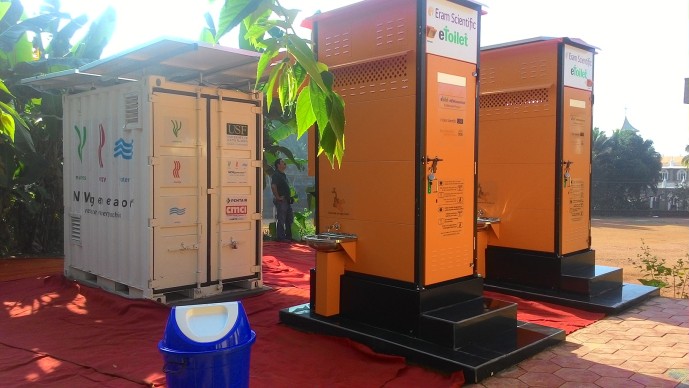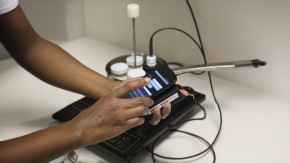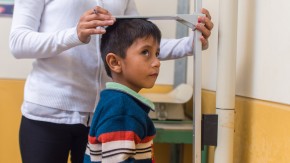
The first flush toilet was invented for Queen Elizabeth I in 1596. In 1775, the Scottish watchmaker Alexander Cummings patented the S-trap, a plumbing configuration that uses standing water to trap sewer gases. The S-trap, in turn, made possible a device that changed the world: the modern flush toilet.
Since then, toilet technology hasn't changed much. In the developed world, most people still rely on contraptions very similar to the one Cummings invented - toilets that consume around 5,000 gallons of drinking water per person every year and only protect from diseases if they're connected to a network of elaborate, antiquated underground sewer systems and expensive wastewater-treatment plants.
Meanwhile, 4.5 billion people around the world don't have access to proper, safely managed sanitation systems at all. In developing countries, scientists estimate that 90 percent of human waste (and all the viruses, bacteria, and parasites it carries) ends up back in the environment - including in the food people eat and the water they drink - without being treated. As one result, diseases caused by poor sanitation are estimated to kill more children every year than HIV, measles, and tuberculosis combined.
Sewers have their place - but the solution to this problem isn't simply to bring old-fashioned, water-hogging, sewer-connected toilet systems to the people who don't currently have access to them. It's to come up with something new. So, almost 10 years ago, the Gates foundation's Water, Sanitation & Hygiene program and the Grand Challenges Explorations (GCE) team devised the precursor to today's Reinvent the Toilet Challenge: a call for proposals to create the next generation of sanitation technologies.
Reinvented toilets needed to process human waste safely on site and work without a connection to water, sewer, or electrical infrastructure. They also needed to be inexpensive to build and operate. Finally, they would have to have commercial potential so that someone, eventually, would pay to manufacture and distribute them: for instance, they might turn waste into valuable resources like clean water or energy, or they might spur a whole new line of profitable businesses in charge of servicing them. No matter how they worked, as one internal document later put it, they would need to be "truly aspirational next-generation product[s] that everyone will want to use - in developed as well as developing nations."
These were two of the most aspirational next-gen innovations to come from that GCE call:
From waste to water
In 2012, University of South Florida engineering professor Daniel Yeh used a GCE grant to build a mini–sewage-treatment plant called the NEWgenerator. ("NEW" stands for "nutrients, energy, and water.") The solar-powered NEWgenerator connects to flush toilets and uses a two-part anaerobic disinfection process - followed by filtration, then chlorination - to recycle water that can then be used to flush toilets again or irrigate crops. It can also produce nutrient-rich fertilizers from disinfected solid waste and biogas that can be burned for limited heating or cooking.
In 2016, Dr. Yeh's team field-tested NEWgenerators that could serve as many as 100 people per day at a school in southern India. Today, much larger NEWgenerators that can serve about 250 people per day are in use alongside a Community Ablution Block (a small facility with toilets, showers, and sinks) in water-scarce Durban, South Africa, where water recycling is especially imperative. Recently, Dr. Yeh has teamed up with another foundation-funded innovator: an Indian company called Eram Scientific that manufactures solar-powered, fully automated, self-cleaning modular toilets known as eToilets. Together, eToilets and NEWgenerators make a safe, clean, closed-loop sanitation cycle that's ready for use in cities around the world.
Urinetricity
In 2011, Ioannis Ieropoulos, a professor of Bioenergy and Self-Sustainable Systems at the Bristol Robotics Laboratory (BRL) at the University of West England-Bristol, was awarded a GCE grant for a microbial fuel cell (MFC) that converts urine into electricity. The BRL team explains how it works: Power (branded as "Pee Power") is generated in microbial fuel cells in which live microbes feed on urine (the fuel) and poop out electrons, which can be collected as electricity. This green technology also cleans the urine so that the by-product can be used as a crop fertilizer.
Over the past several years, the system has been used to power overnight LED lights in the toilet facilities at the Seseme Girls' Secondary Boarding School in Kisoro, Uganda, the Brainhouse School in Nairobi, and the Thandanani Community in Durban, South Africa. It's also been used to power lights, information boards, cell-phone chargers, and even Game Boy players at the Glastonbury Music Festival in England. Soon, you'll be able to find a demonstration MFC toilet in the new Queen's Terminal at Heathrow Airport in London.
(An interesting side note: Ieropoulos's prototype system currently costs more than equivalent solar panels do - but in many places, solar panels are often stolen as soon as they're installed. Demand for boxes of urine, by contrast, seems to be not nearly as high. This makes MFCs the more economical choice - and at the same time, they show just how valuable human waste can be.)
What's next for Pee Power? For one thing, the BRL researchers hope to build MFCs with enough current density to power the streetlights at refugee camps run by Oxfam.
Other noteworthy GCE toilet innovations include a low-cost, decentralized sanitation system that uses a waterless vacuum to collect excrement and kitchen waste, which can then be processed into organic fertilizer, a simple auger-die assembly that composts fecal waste before it can contaminate the ground water, a toilet with a hand-cranked sewage-treatment system to process feces into odorless pellets that can be used for fertilizer or fuel, a plant-based waste-treatment system for houseboats, and a self-cleaning latrine made from hydrophobic materials.
Together, the responses to the GCE calls for proposals and the Reinvent the Toilet Challenges nudge us closer to a future in which safe, sustainable sanitation is available around the world to everyone who needs it. It's a future in which the only place you'll find an old-fashioned drinking-water–guzzling toilet is a museum.



